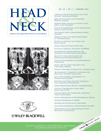Routine central compartment lymph node dissection for patients with papillary thyroid carcinoma†
This work was presented at the American Head and Neck Society Seventh International Conference, San Francisco, California, July 21, 2008.
Abstract
Background
The role of routine central compartment neck dissection in papillary thyroid cancer is controversial.
Methods
A retrospective medical record review was conducted of 83 patients with papillary thyroid cancer who received either total or hemithyroidectomy and central compartment lymphadenectomy.
Results
Positive central compartment node metastases were found in approximately equal rates between older and younger patients (38.9% and 42.6%, respectively; Fisher's exact test; p = .82). The primary tumor was a microcarcinoma (1 cm or less) in 32 patients (38.5%). Positive central compartment node metastases were detected in 31.3% of patients with microcarcinomas, compared with 47.1% of patients with tumors greater than 1 cm.
Conclusion
Younger and older patients had approximately equal rates of central compartment lymph node metastasis. There was also a similar rate of metastasis between microcarcinomas and larger tumors. Our results document that central compartment lymph node dissection is a safe operation and may decrease the need for further operations. © 2011 Wiley Periodicals, Inc. Head Neck, 2012




